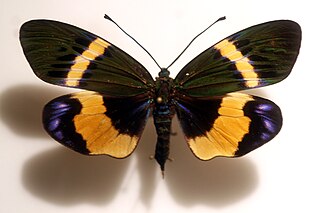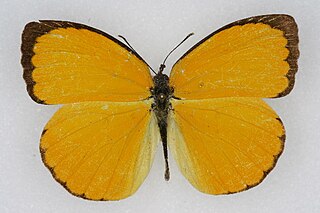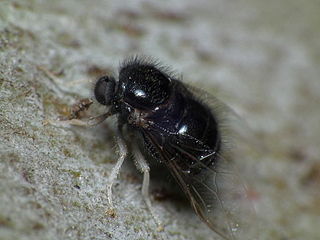
Chalcosiinae is a subfamily of the Zygaenidae, containing many species, mostly little known. Prominent sexual dimorphism, bright aposematic coloration and mimicry complexes are widespread.
Colophon westwoodi is a species of beetle in the family Lucanidae. It is endemic to South Africa.

Syntelia is a genus of beetles. It is the only genus in the family Synteliidae. There are seven known species, which are native to high-elevation regions in southern North America from central Mexico to Guatemala, and in eastern Asia, from India to Japan and eastern Russia. They are generally associated with rotting logs, typically found under bark, though the Mexican species S. westwoodi has been found inside large decaying columnar cacti. Adults and larvae are predatory, feeding on insect larvae. A fossil species, Syntelia sunwukong, is known from the Late Cretaceous (Cenomanian) aged Burmese amber of Myanmar. Adults are around 1–3.5 centimetres (0.39–1.38 in) in length. The characteristics of the family and genus include geniculate antennae with 3-segmented club, elongate body, narrowly separated coxae and tarsi with bisetose empodia. Only one abdominal segment is exposed behind elytra. The genus described by John O. Westwood in 1864, while the family was erected by George Lewis in 1882. They are members of Histeroidea, which also includes clown beetles (Histeridae).

Leptofoenus is a genus of wasp in the family Pelecinellidae found in South America, Central America, and southern North America. The genus contains five living species and one extinct species known from early Miocene Burdigalian stage Dominican amber deposits on the island of Hispaniola. With body sizes ranging from 11–27 millimetres (0.43–1.06 in) Leptofoenus species are larger than nearly all other species in Chalcidoidea. The genus bears a notable resemblance to the wasp families Pelecinidae, Gasteruptiidae, and Stephanidae.
Anaulacus is a genus in the beetle family Carabidae. There are more than 30 described species in Anaulacus.

Eurema dina, the dina yellow, is a butterfly in the family Pieridae. The species was first described by Felipe Poey in 1832. It is found from Panama north to southern Florida.
Cormocephalus westwoodi is a species of centipedes in the family Scolopendridae. The species was previously considered by many names in many regions of the world, where some synonyms are still exists valid in certain countries. Five subspecies are currently recognized.
Campodea westwoodi is a species of two-pronged bristletail in the family Campodeidae.

Paramesius is a genus of hymenopterans in the family Diapriidae.

Anotia is a genus of derbid planthoppers in the family Derbidae. There are at least 20 described species in Anotia.
Elephantomyia westwoodi is a species of limoniid crane fly in the family Limoniidae.

Pterodontia is a genus of small-headed flies. There are at least 20 described species in Pterodontia.
Pterodontia notomaculata is a species of small-headed flies.
Pterodontia flavipes is a species of small-headed flies. Adult males are 5.5–10.5 mm in size, while adult females are 5–9 mm. The larvae are thought to enter their host spiders at the leg articulations. First instar larvae of the species have also been recorded attacking the mites Podothrombium and Abrolophus.
Ocnaea sequoia is a species of small-headed flies in the family Acroceridae.
Ocnaea is a genus of small-headed flies. There are 20 described species in Ocnaea.
Pterodontia misella is a species of small-headed flies. It is very close in appearance to Pterodontia flavipes, and was considered a synonym of it by Curtis Williams Sabrosky in 1948. However, this synonymy has not been adopted by later authors, and P. misella is still recognised as a distinct species.
Pterodontia johnsoni is a species of small-headed flies.
Pterodontia vix is a species of small-headed flies.

Elcysma westwoodi, commonly known as the white-tailed zygaenid moth, is a species of moth in the burnet moth family Zygaenidae. It has a Palaearctic distribution, being found in Japan, the Korean Peninsula, China, and the Russian Far East. The species was first described by Samuel Constantinus Snellen van Vollenhoven in 1863 as Agalope westwoodii.







